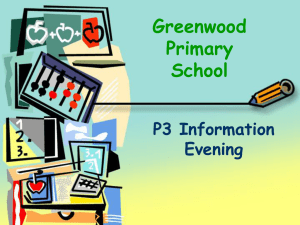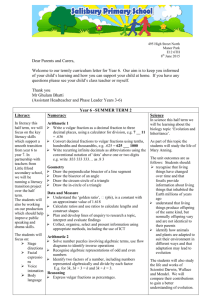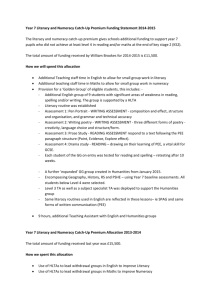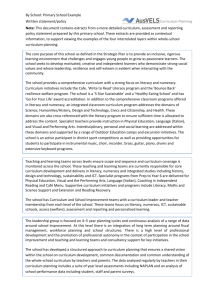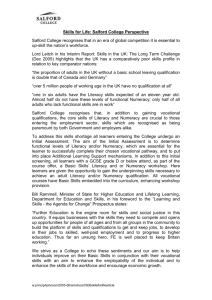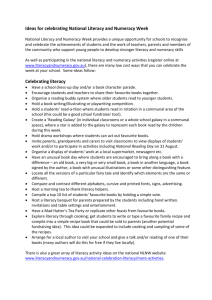School Plan 2010-2011 - Bellbird Public School
advertisement
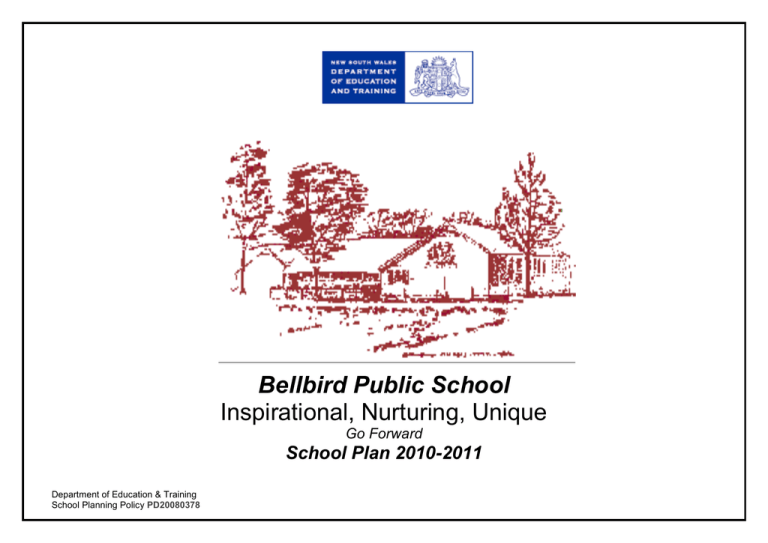
Bellbird Public School Inspirational, Nurturing, Unique Go Forward School Plan 2010-2011 Department of Education & Training School Planning Policy PD20080378 School Plan for 2010-2011 School context Bellbird Public School has 250 students and serves a diverse community. A mix of experienced and beginning teachers work together to create a friendly, welcoming school culture. School enrolments have been falling slightly over the last 4 years. The school has worked tirelessly over the last three years to improve literacy and numeracy outcomes. Significant improvement is evident in the NAPLAN areas of writing 07/08, and reading 08. Improvement between year three and year five in literacy has been above state and now national average. However, NAPLAN results also reveal a less than national average growth between years three and five in Reading . School based assessment data shows an average increases of 18%-25% when looking at the 08 and 09 targeted areas of literacy and numeracy. Significant progress has been made in improving levels of student well being with programs including Crunch and Sip, Active After School Community and Positive Behaviour for Learning being implemented. The parent community support major school initiatives well. However, parent participation at the decision making level is low. Changes in the welfare policy will see a revised rewards system being implemented in 2010 and beyond. A planned development for Bellbird North will occur in the next three years. This will impact on student numbers at Bellbird School. Priority Areas (3 year horizon) Strengthen teacher capacity to improve student outcomes in Literacy. Strengthen teacher capacity to improve student outcomes in Numeracy. Improve student and community engagement in the whole school setting. Intended Outcomes (Summary) School based data will show each child improving in the targeted areas of literacy and numeracy.. Teaching and learning programs will be collaboratively produced and align with whole school targets and priorities. School community engagement with the school increases and student engagement in the class context. Targets To increase individual student proficiency in selected reading and writing skills and understandings by 20% as measured by the use of common marking criteria. To increase individual student proficiency in selected numeracy and measurement skills and understandings by 20% as measured by the use of stage assessments. To increase the number of students achieving expected growth in literacy between year 3 and 5 to 85%. To increase the number of students achieving expected growth in numeracy between year 3 and 5 to 85%. To increase student engagement in class activities as evidenced by systematic data collection and to increase parent engagement in curriculum workshops and advisory roles. The plan has been endorsed and approved by: Principal: Department of Education & Training School Planning Policy PD20080378 Date: School Education Director: Date: School Plan Priority Area: Intended Outcomes: Strengthen teacher capacity to improve student outcomes in Literacy School based data will show each child improving in the targeted areas of literacy and numeracy.. Teaching and learning programs will be collaboratively produced and align with whole school targets and priorities. Whole school focus areas will be scoped across the school year and will align with curriculum requirements. Targets 2010- To increase individual student proficiency in selected reading skills and understandings by 15% as measured with common assessment criteria and reported against the specific action plan. To increase the number of students achieving one skill band of growth to 85% 2011 - To increase individual student proficiency in selected reading and writing skills and understandings by 15% as measured with common assessment criteria and reported against the specific action plan. To increase the number of students achieving one skill band of growth to 85%. Timeframe Indicators Responsibility Strategies 09 Teachers demonstrate expertise and competence to improve student outcomes in Reading, Writing and Talking and Listening A comprehensive scope and sequence is developed. Corporate programming occurs in a culture of support and sharing. Individual needs are met and extended within the corporate planning framework The elements of QT are evident within the Program and practise of each classroom. 10 11 Engage in P/L to increase teacher capacity to improve student outcomes in all aspects of literacy teaching. Principal and Executive. Regional Staff Implement Reading 3-6 across the school. Principal, Executive, Key Staff. Develop whole school programming approaches and formats in a consistent manner K6. Build corporate programming models into stage and school organisational patterns. Scope purpose of writing and Reading across the year. Ensure scope aligns with targeted areas of improvement. Corporately program units of work. Include CATs which demonstrate the A-E reporting scheme. Incorporate a Differentiated Learning model to cater for gifted students in the regular classroom. Department of Education & Training School Planning Policy PD20080378 Revisit the concepts central to Quality Teaching. Tie QT into the corporate programming model. Resource Allocation & Funding source T.P.L Funds, $5000 pa. Planning time, $1000 Principal , Executive, Staff. Principal, Executive. GATs Committee in consultation with staff. Regional support Local expertise. Principal and Executive Planning, CTJ Day $1500. TPL funds as required. $1500 pa Scope targeted areas of improvement across the year. Treat each set of focussed criteria as pre assessment, P/L, explicit teaching and post assessment. Develop rubrics on a stage basis. Use data to drive future focus areas. Report annually. Review the focus on spelling. Support guided reading in stage two and three classes by allocating the STLA, Literacy support Aide and class aides to reduce group size. Student outcomes are improved in Tthe Targeted areas. Guided Reading occurs in a Systematic and purposeful manner. School, state and national data is d Used to determine priorities and set directions. Individual student growth is a shared Responsibility. Planning Time TPL, 1 $1000. English Committee Nil Principal and STLA TAS funded from Learning Assistance Funds. $5000 pa Use a range of data from NAPLAN, standardised tests, and class assessments to determine students at risk or requiring extension. Teachers and Principal. Maintain the LST model to develop goals and include parents in the achievement of them. Learning Support Team. Investigate grouping options across the school in literacy. Technology is integral to effective teaching. Principal, executive and English Committee. PBL produces demonstrable improvements. Department of Education & Training School Planning Policy PD20080378 Utilize technology to engage students in their literacy sessions. Ensure technology use has the primary aim of increasing student outcomes and enhancing student engagement. Conduct P/L in aspects of technology and the literacy session. Ensure hardware and soft ware align and support the effective literacy session. Principal and Executive Technology coordinator and technology committee Use the Positive Behaviour for Learning framework to target and improve specific aspects of the In Class context using the revised Gold Medal System. Ensure Professional Learning is targeted and effective in relation to PBL. PBL Committee Implement the Best Start Program. Communicate with the local pre school to maximise student transition outcomes. Stage One Executive Implement literacy workshops for parents. Include literacy tips and strategies in the newsletter. Deliver literacy tips and strategies at assemblies. Principal and Executive Computer Coordinator allowance $3000. pa $1000 for ongoing training TPL. pa $600 school funds to support inter school visits. School Plan Priority Area: Intended Outcomes: Targets: Strengthen teacher capacity to improve student outcomes in Numeracy School based data will show each child improving in the targeted areas of numeracy. Teaching and learning programs will be collaboratively produced and align with whole school targets and priorities. Whole school focus areas will be scoped across the school year and will align with curriculum requirements. 2010- To increase individual student proficiency in selected maths skills and understandings by 15% as measured with common assessment criteria and reported against the specific action plan. To increase the number of students achieving one skill band of growth to 85%. 2011 - To increase individual student proficiency in selected maths skills and understandings by 15% as measured with common assessment criteria and reported against the specific action plan. To increase the number of students achieving one skill band of growth to 85%. Timeframe Indicators Responsibility Strategies 09 Teachers demonstrate expertise and competence to improve student outcomes Numeracy A comprehensive scope and sequence is developed. Corporate programming occurs in a culture of support and sharing. Individual needs are met and extended within the corporate planning framework The elements of QT are evident with in the Program and practise of each classroom. Engage in P/L to increase teacher capacity to improve student outcomes in all aspects of numeracy teaching. 10 11 Principal and Executive. Regional Staff Resource Allocation & Funding source T.P.L Funds, $5000 pa. Maintain and implement the scope and sequence of outcomes for each stage in Maths and best practice statements for each Maths strand. Principal, Executive, Staff. Planning time, $1000 Develop whole school programming approaches and formats in a consistent manner K-6. Build corporate programming models into stage and school organisational patterns. Target early and late stage outcomes. Principal , Executive, Staff. $300 to print said paper work. Incorporate a Differentiated Learning model to cater for gifted students in the regular classroom. Revisit the concepts central to Quality Teaching. Tie QT into the corporate programming model. Department of Education & Training School Planning Policy PD20080378 GATs Committee in consultation with staff. Principal, executive and regional staff. Nil. Student outcomes are improved in targeted areas. Individuals and groups have their needs met and extended. Technology is integral to effective teaching. Investigate grouping structures across the school such as Newman’s ’, C Min Too, gender and ability. Utilize school STLA resources to target students experiencing difficulty in numeracy. School funded teacher resources used to create gifted and talented maths groups within the school. Utilize technology to engage students in their numeracy sessions. Ensure technology use has the primary aim of increasing student outcomes and enhancing student engagement. Conduct P/L in aspects of technology and the numeracy session. Ensure hardware and soft ware align and support the effective numeracy session. PBL produces demonstrable improvements. School, state and national data is used To determine priorities and set directions. The community is more involved in day to day school activities. Scope targeted areas of improvement across the year. Treat each set of focussed criteria as pre assessment, P/L, explicit teaching and post assessment. Develop marking scales on a stage basis. Use data to drive future focus areas. Department of Education & Training School Planning Policy PD20080378 Use the Positive Behaviour for Learning framework to target and improve specific aspects of the In Class context using the revised Gold Medal System. Ensure Professional Learning is targeted and effective in relation to PBL. Use a range of data from NAPLAN, standardised tests, SENA, and class assessments to determine students at risk or requiring extension. Investigate the use of community support personnel for specific numeracy based projects. Principal, Executive. Maths committee and executive. STLA Learning Assistance Funds $2500 pa Maths Committee $1000 KLA budget area pa Technology Committee, Computer Coordinator Computer Coordinator allowance $3000. pa PBL Committee Nil Principal, Staff and Executive Nil Principal, Executive. Maths Committee. Implement maths workshops for parents. Include maths tips and strategies in the newsletter. Deliver maths tips and strategies at assemblies. TPL funds as required Planning TPL, $1000pa School Plan Priority Area: Improve student and community engagement in the whole school setting. Intended Outcomes: School community engagement with the school increases as does student engagement in the class context. Targets: 2010 - To increase student engagement in class activities as evidenced by pre and post survey data and in conjunction with the PBL Process. To increase parents nominations for leadership and advisory roles with in the school’s governance structures. To maintain high levels of student engagement. To further promote and establish effective decision making structures in the school. 2011 - To review student engagement levels through PBL data analysis. To review parent participation levels in governance structures. Timeframe Indicators Responsibility Strategies 09 Students are engaged in dynamic classrooms in which explicit teaching, quality learning environments and high expectations exist. Individual strengths are built upon. Individual potential is realised. Targeted behaviours are demonstrably improved. Students are listened to. Department of Education & Training School Planning Policy PD20080378 Develop and implement the best teaching and learning processes possible. Appropriate grouping, differentiated learning opportunities, individual programs and well structured lesson will be implemented to increase student engagement in all classrooms. The QT elements of Engagement, Significance and Quality Learning Environment will be integrated into all programming, assessment and planning strategies. Cater for all learning styles by deliberately planning and programming integrated units of work which have high levels of significance and intellectual quality. Maintain the school’s commitment to the Independent Learning Group, Maths Olympiad, Learning Support team model and open school culture. Use the PBL process to improve specific aspects of learning behaviour. Focus on Transition P-K, 6-7. 10 11 Resource Allocation & Funding source Principal and Executive. Regional Staff $1000 TPL. pa Principal, Executive, Staff. Nil Principal and Executive. Regional Staff $1000 TPL pa Principal, Executive, Staff. Staffing allocation to support these groups. PBL Committee Educational outcomes of Aboriginal students are improved. The gap is reduced. Use technology to engage, enthuse and inspire our students. Develop and implement personal learning plans for all Aboriginal and non Aboriginal students. Include Aboriginal perspectives in all class literacy, numeracy and COGS units. Aboriginal culture is celebrated and recognised at all times. The community is involved in the school on a number of levels. Communication is clear, explicit and relevant. Executive Nil Technology Committee Computer Coordinator. See allocated technology funds $300 pa as required for release. Maintain an Aboriginality perspective in all special events and assemblies. Support and encourage Middle Years Aboriginal Camp. Recognise and celebrate Aboriginal culture on significant days. Ensure Reconciliation Action Plan is current and incorporated into school and class programs. Principal, executive and staff. $200pa resource acquisition. Principal RAP committee $300pa release costs Maintain the schools strong focus on sport. Stage two and three executive Investigate community programs such as the Grand Friends Program, Focus Group meetings, Meet the Principal Morning Teas and Gender specific information sessions. Nil. All staff. Further establish student voice opportunities such as class meetings, SRC forums and student leader meetings. AP Stage Three, AP St 1. Initiate parent activities which encourage parenst to come into the school and engage with the decision making processes and information collection. Ensure communication systems within the school and external to the school have a consistent theme and target specific audiences. Ensure Bellbird is proactively promoted as a quality school which is an integral part of the Bellbird community. Initiate communication structures which feed back community concerns and issues. Bellbird is seen as an excellent school. Staff representatives Principal School Promotions Team School Evaluation Team. Department of Education & Training School Planning Policy PD20080378 Release and resource costs as needed. $1000 school promotions budget.
